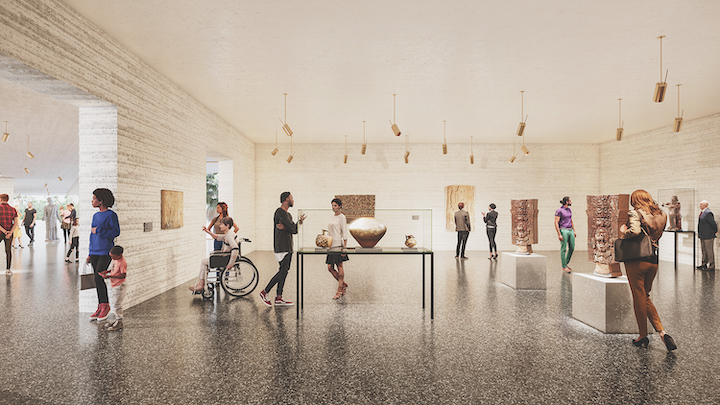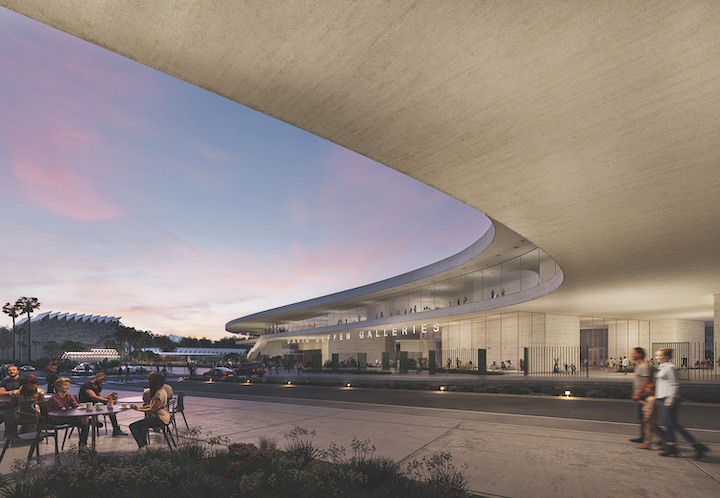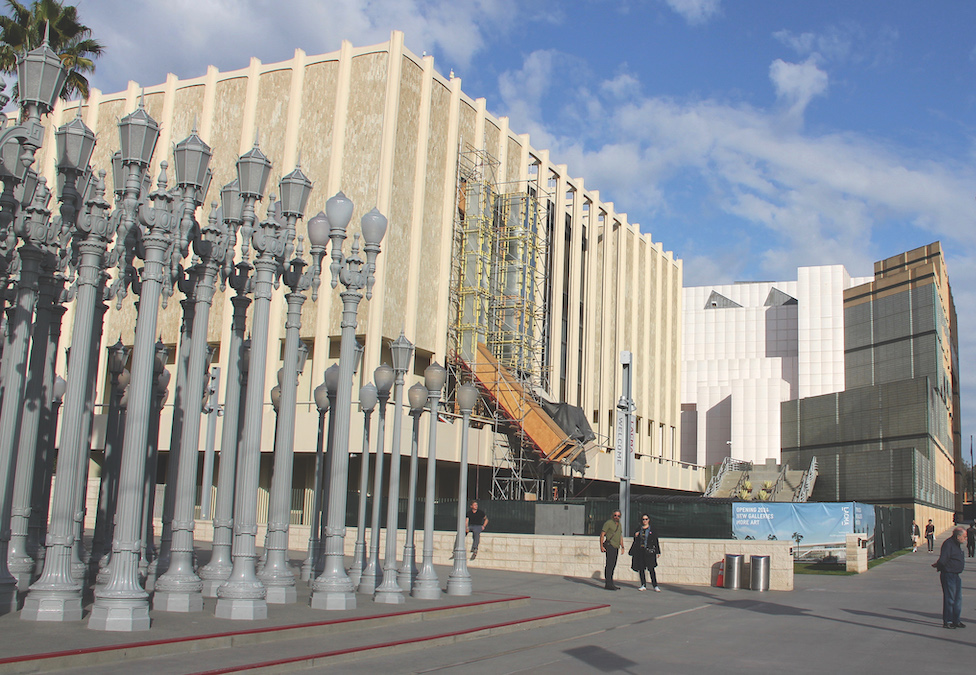LACMA on track to build Geffen Galleries up and across Wilshire

LACMA on track to build Geffen Galleries up and across Wilshire

GEFFEN GALLERIES are supported by semi-transparent concrete and glass pavilions that include the new location of Ray’s and Stark Bar (in the left of the rendering) as well as education studios, the LACMA Shop, a café and — across Wilshire — another café and a theater. View is from the Broad Contemporary Art Museum (BCAM) balcony, looking east. “Urban Light” is at lower right.
A world-class art gallery that will stretch across Wilshire Blvd. over traffic below seems so quintessentially car-centric Los Angeles, it’s almost surprising it wasn’t thought of before.
But the design for the David Geffen Galleries was more a process of happenstance than a clear strategy.
“It was a big idea. It was a simple idea,” LACMA CEO and Hancock Park resident Michael Govan said last month as pre-construction was underway.
Architect Peter Zumthor’s original design — all on the north side of Wilshire and which debuted in 2013 — was too big and too close for comfort for its neighbor, the Natural History Museum of Los Angeles County’s Tar Pits Museum and its Ice Age-era paleontological sites.
So Zumthor, Govan and the museum board and staff went back to the drawing board, literally. They scaled back the building’s size, and, then, a collective light bulb went off.
“We quickly thought that we’d swing the building across the street,” Govan said.
Zumthor’s design raised the gallery building up and off the ground, and since “you could already walk underneath, it seemed a logical step to drive underneath,” Govan explained.
The funny thing is, he added, Zumthor’s first drawing had a pedestrian bridge crossing over the busy boulevard.
“[Zumthor] thought how amazing it is that we own both sides of the street…” and he proposed the bridge.
“We said, forget that, it would never be approved,” laughs Govan.
In the end, something much bigger was approved:
Seven semi-transparent pedestal structures will support the elevated exhibition level with its floor-to-ceiling glass perimeter. At ground level, the pedestals will house cafés, a restaurant and a theater. The latter will be on the south side of Wilshire on the museum’s Spaulding Ave. property, currently a parking lot.
Keck Foundation gift

RENDERING of a room in the new Geffen Galleries building.
A recent gift of $50 million from the W.M. Keck Foundation pushed the fundraising campaign to $640 million of LACMA’s $650 million goal. An additional public phase campaign to raise $100 million more will commence as construction gets underway.
Since arriving to Los Angeles almost 14 years ago, Govan has been guiding the years-long planning process from initial design and environmental reviews to community meetings, the fundraising campaign and now construction.
“After a decade of intense work by so many people to make this successful, it’s finally here,” said Govan.
Well almost. There will be three years of construction and another year to move in. The new museum gallery building is expected to open in the spring of 2024, in time for the Metro Purple Line’s debut. (The Fairfax subway station is on Ogden Drive, across Wilshire from the museum.)
Geffen Galleries replaces four buildings (Ahmanson, Hammer, Art of the Americas and the Bing Theatre).
It will join the Broad Contemporary Art Museum (BCAM), designed by architect Renzo Piano, the Resnick Pavilion (also by Piano) and the Bruce Goff-designed Pavilion for Japanese Art, giving LACMA a total of 222,000 square feet of gallery space.
Ten years ago, before BCAM and Resnick were built, LACMA’s exhibit space totaled 110,000-square feet.
Another plus is the project adds 3.5 acres of public space to the 20-acre Hancock Park. There will be new landscaped plazas, educational spaces, sculpture gardens and native vegetation.
The new building design is not without controversy. Two separate groups claiming to be “Save LACMA” are fighting over that name in their efforts to do what their mem

AFTER: Visible on the left in this rendering of the view north across Wilshire Boulevard are “Urban Light,” BCAM and the Resnick Pavilion. The view is from the café that will adjoin the theater at the corner of Wilshire Blvd. and Spaulding Ave.
bers believe the name says. One group was founded by local preservationists who are partial to the legacy of architect William Pereira, FAIA. Pereira’s firm designed the original graceful buildings from 1965 that were obscured by the hulking Hardy Holzman Pfeiffer addition along Wilshire in 1987. LACMA officials and their consultants say all those existing structures need replacement.
The other “Save LACMA” group seemingly is led by architecture critics, one prominent in New York and the other a local Los Angeles writer. But, possibly only the Los Angeles writer is behind that Save LACMA. That version of Save LACMA appears well-funded; it has placed three full-page ads in the “Los Angeles Times” (and possibly ads in the “New York Times” and other papers) featuring cartoon images of the proposed Zumthor building, along with strong criticism of LACMA, its leaders and their plans. The source of funding for those ads is unknown.
Neither “Save LACMA” poses a threat, said Govan. The money for the project has been raised. In some cases, the pledges are pending the completion of the new state-of-the-art galleries building. City and county approvals have been granted, with officials praising the project. “It was a really innovative way to solve your problem and make a landmark building for Los Angeles,” one told Govan. Govan does sympathize with those who are nostalgic for the three 1960-era Pereira buildings that the new gallery building will replace.
In fact, he hired Zumthor largely based on his experience in reusing older buildings. “When I originally spoke with him, I hoped we could build around the older buildings.” But very quickly Govan and Zumthor came to the same conclusion a previous architect on the project reached. “We started to quickly learn that Rem Koolhaas was right.”
In 2001, Koolhaas’ design also called for demolishing the older buildings to rebuild LACMA. That plan also required closing the museum for five years. The project died when the money ran out.
“This is the second big attempt. This time it’s working,” said Govan.

DEMOLITION UNDERWAY: In this “before” view, photographed adjacent to “Urban Light” in February, disposal chutes on the Ahmanson Building are where interior elements of the old buildings are being removed. The Art of the Americas (Robert O. Anderson) Building at right also is going away.
Govan also noted that, in addition to taking more time, saving the deteriorating buildings would have cost hundreds of millions of additional tax payer dollars.
“This is an amazing solution. You’re going to finally have this much expanded, state-of-the-art world-class museum not just in its collection, which is growing,” but designed by “one of the best architects.
“I can’t wait. I think the gallery experience is going to be sublime.”
Remains open
LACMA will remain open during construction, showcasing its and others’ works in BCAM and the Resnick Pavilion. Ray’s and Stark Bar (and, of course, the popular “Urban Light,” by artist Chris Burden, at the museum’s Wilshire entrance) also will also remain open.
The LACMA Sundays Live free music series previously in the Bing Theater is now being offered at St. James’-in-the City, 3903 Wilshire Blvd. See sundayslive.org.
John Welborne contributed to this story.
Category: News
